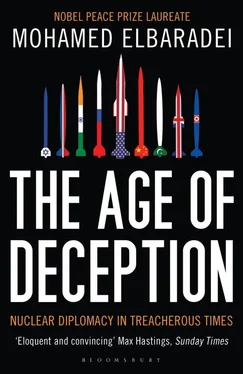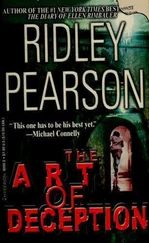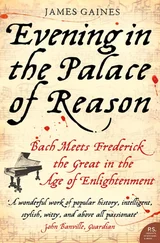The Iranians agreed to intensify their cooperation with the IAEA but pointed out that the prevailing perception in Tehran was that working with the Agency had gotten the country nothing. Iran’s hard-liners, who had recently gained control of the Majlis, the parliament, were decrying Tehran’s voluntary suspension of its enrichment activities as a sellout to the West. The “moderates,” who favored a diplomatic solution and normalization with the West, were losing ground. If my upcoming June report to the IAEA Board was negative, Rowhani said, he doubted that he and his colleagues would be permitted to continue their current level of cooperation with the Agency or keep their posts. The moderates hoped, at a minimum, to see positive reactions from the Europeans, so they could say to the Iranian public that their policy was paying off.
The difficulty for the Iranians, as I saw it, was that their government had oversold its nuclear program. They had presented it domestically as the jewel in Tehran’s crown, a scientific achievement for the nation. This made it tough to explain why they were suspending it. Of course, they neglected to point out to the Iranian public that the suspension was a consequence of having deceived the IAEA for years. Instead, they argued that U.S. pressure on the Agency was slowing down the verification process.
Here was another hallmark of the Iranian situation, not dissimilar to other nuclear crises, such as Iraq or North Korea: the domestic use, in both Tehran and Washington, of the other nation’s supposed ill will. This genie, once decanted, was hard to contain. My treatment at the hands of the Iranian media reflected how public opinion was shaped. For example, an article in the Tehran Times reported “observers in Vienna” saying that “ElBaradei… has become depressed and passive” due to the extreme pressure I was facing from the Americans. [16] “IAEA Breaches Legal Commitments Towards Iran,” Tehran Times , February 19, 2004.
Iranian reporters asked repeatedly, during my visit, how I was dealing with this pressure. “I am under pressure from everyone,” I said, smiling. “Americans, Iranians, and everyone else.” But I felt less lighthearted than I sounded. It was clear to me, from the questions I was being asked and from the attitudes expressed in the Iranian press, that the nuclear program was becoming a major domestic issue and a matter of national pride. This was not a good sign.
The Iranian authorities also believed they had cards of their own to play. If relations with the Americans did not improve, Rowhani told me, Iran was confident that it could make the situation in Iraq even more difficult. I discouraged any form of retaliation.
On my return from Tehran, I urged Ken Brill, the U.S. ambassador, and John Wolf, the assistant secretary of state, to search for a way to start a dialogue with Iran or, at a minimum, to make a positive gesture. “If we all share the same objective—that we do not want to see a nuclear weapon in Iran—we need to develop a coherent endgame strategy,” I said. I made similar overtures to the EU-3 ambassadors. I explained that Iran’s hard-liners were gaining power because of the meager results from cooperation with the IAEA. A policy of pressure alone, I said, would not work, “particularly since no one in the West has clear evidence of an Iranian nuclear weapon program.” With no incentives, the Iranians might take any number of actions: they could restart their enrichment program, back away from their Additional Protocol, or even withdraw from the NPT.
Perhaps I ought to have saved my energy. In June, the IAEA Board issued a resolution that “deplored” Iran’s lack of “full, timely, and proactive” cooperation with the Agency. There was, of course, some basis for the criticism. But Iran was infuriated. The Iranian hard-liners in the government could now say, “I told you so.” Less than a week later, Iran informed the IAEA that it would resume manufacturing and testing centrifuges, although without using nuclear material. I asked them to reconsider, but it was no use. The Agency’s seals were removed, and Iran’s centrifuge engineers went back to work, ending their voluntary suspension on enrichment R&D.
I followed the June Board meeting with in-person pleas during meetings with Colin Powell and his colleagues at the State Department to engage directly with Iran. In another six months, absent the leverage of a “smoking gun,” Iran’s uranium enrichment program would be a fait accompli, and the price for stopping it would be much higher. I also did not think it would do any good to refer Iran to the UN Security Council, as some were again recommending. Iran could withdraw from the NPT, and we would then have another North Korea on our hands.
During my one-on-one with Powell, he said, “If it were up to me, I would meet with Foreign Minister Kharazi tomorrow morning.” The problem, in Powell’s view, was that feelings against Iran had remained very strong in the United States ever since the hostage crisis. Initiating direct dialogue would be difficult. Condoleezza Rice was also surprisingly receptive, asking me about Rowhani, more or less her counterpart at the time. “What kind of a person is he?” she wanted to know, giving the encouraging impression that she was at least entertaining the idea of engaging the Iranians.
A constructive contribution came from President Vladimir Putin, whom I visited at his summer house in Moscow. Contrary to allegations made at times by the West, Putin strongly opposed Iran’s acquisition of nuclear weapons and questioned its need for nuclear enrichment capability; but he concurred that Iran should be offered attractive assistance, including nuclear technology, and he supported an international guarantee of reactor fuel supply. Putin had also put forward an idea for an international repository for spent fuel, which I applauded. A multilaterally controlled repository would help to stem proliferation risks from this sensitive stage of the fuel cycle and would boost the expansion of safe and secure nuclear power. I felt hopeful that Russia might help bring resolution to the Iranian situation. [17] I had met Putin once before at the newly renovated Kremlin during the first year of his presidency. While the Iranian nuclear file was not on the table at that time, I found him to be thoroughly engaged on nuclear issues, and he subsequently spoke out in support of the Agency on several occasions to counter U.S. criticism.
Meanwhile, IAEA inspectors were redoubling their efforts to determine the origin of the enriched uranium particles found at various locations in Iran. To prove or disprove Iran’s contention—that the source was contamination from centrifuge components imported from Pakistan—we needed environmental samples from Pakistani centrifuges to compare with our sample results from Iran’s equipment. The IAEA Board had urged all relevant “third countries” to help clarify the matter, but according to Pakistani ambassador Ali Sarwar Naqvi, the Americans had told Pakistan they had given the IAEA enough support. Apparently, some individuals in Washington were not anxious to see the contamination question settled.
Tired of this behind-the-scenes shenanigans and the resultant sluggish progress, I pressed the Pakistanis for their assistance. The Pakistanis (who are not party to the NPT) were reluctant to allow inspectors into their enrichment facilities, which were on military sites. But they agreed to take samples for us, using analysis techniques that would minimize any potential for manipulation of the results.
By mid-August 2004 we had our first analyses. The samples from Pakistan correlated strongly with most of the high-enriched uranium contamination we had found at Natanz and the Kalaye Electric Company. The evidence was not yet conclusive, but it tended to support Iran’s explanation.
Читать дальше












